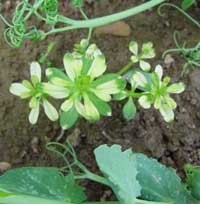Early cleavers control crucial this spring

Controlling broad-leaved weeds early this spring could boost winter cereal yields, equating to a benefit of more than £200/ha, according to Dow AgroSciences.
“Cleavers is the most competitive weed species in cereals,” says Stuart Jackson, the company’s customer agronomist.
“Our own trials to investigate the impact of control measures between GS30 and 39 found that, by sticking to traditional later control programmes, growers reduce winter wheat yield potential by up to 2.2t/ha.
With forecasts of an economically tough year ahead, it will be critical to take full advantage of every opportunity to optimise production.
“Many growers leave it until late in the season before they tackle cleavers but by then the damage has been done. The crop’s yield and economic potential will have been severely reduced.
“The situation will be particularly acute this spring because dry seed-beds in autumn reduced the effectiveness of broad-leaved weed control from pre-emergence herbicides and delayed the emergence of blackgrass, which reduced the opportunity to apply Atlantis (mesosulfuron +
iodosulfuron) in the autumn.
“Under those conditions cleavers and other weeds have fared quite well and could pose a considerable threat this season.”
Mr Jackson highlights two weed control strategies ensuring that cleavers are controlled before they compete with the crop from GS32.
“In situations where growers will be applying Atlantis in the spring, they should seriously consider including 50 or 75ml/ha of Boxer (florasulam) and applying it as soon as active growth begins at the end of February or in early March.
Where Atlantis was applied in the autumn, growers could apply 100ml/ha of Boxer at T0 timing, or Starane XL (florasulam + fluroxypr) at 1.25 litres/ha at T1 to ensure that cleavers are controlled before they compete with the crop at GS32 onwards.
“If, at the T0 timing, cleavers are still blue in colour, growers should either increase the rate of Boxer to 150ml/ha or wait until active growth begins and then use 100ml/ha.”

